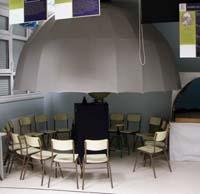From Durango looking at the sky
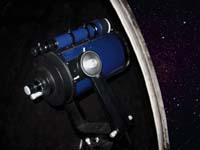
When Joaquin retired, the room and the observatory were closed, but over time they have reopened. From the Izarra Astronomy Society of Durango began to use the observatory and Professor Esteban became responsible for the classroom. Esteban himself has added to the collection numerous didactic modules, some grouped by different places and others elaborated by himself. It is currently the guide to classroom visits.
Observatory
From the outside the most spectacular is the viewpoint, since the presence of a cylinder on a roof and a dome on the top is not usual in towns of the size of Durango. It is located south of the village, where it was once the end of the village -- now, due to the construction of many houses, it is located inside Durango -.

The dome has an eight-inch telescope, more than twenty centimeters. In its day it was a fairly good telescope, model Schmidt-Casse grain. "Of course it's not good about professional telescopes," says Estebanek, "but Saturn's rings and Jupiter's moons and clouds look smooth. The most spectacular thing is to see the surface of the Moon, craters, etc. We have seen the phases of Venus, sometimes comets and other subjects like comet Holmes. Now it doesn't look so good, but a few months ago it was a good show." Special comets for Esteban. Some are newspapers and for him are not very interesting, but others appear suddenly and are very pretty from the point of view of observation, because they can appear on any night.
Esteban is clear that Durango is not the best place to practice astronomy, but better observations can be made than from a large city. He laughs that the ideal place would be the top of the Gorbeia or some other, but that it is not possible to have an observatory. Therefore, you have to look for the best solution.
However, Esteban highlights to visitors that the Durango is a didactic observatory better than the most prestigious in the world, from a point of view at least. "I have been five or six times at the Canarian observatories, both in La Palma and in Tenerife. They are very important places for an astronomer. They conduct in-depth research and astronomy studies. But a visitor who is not a professional can be frustrated, since from a local telescope you can not see anything live. Telescopes have a tool called an eyepiece, to see it from the eye, but years ago large telescopes do not put eyepieces. The images received go directly to the computer or to the videos. And the researcher and visitor see the image through a screen. For the researcher this is a great advantage, since it saves data and images, but for the visitor that way of seeing has no emotion. From this point of view, the installation itself is more interesting than the one visible from the telescope. To see the sky and the stars, a small telescope is much better."
Classroom

In this room there are many didactic modules, more than 30 and many models: a dome with a small planetarium (an umbrella, to tell the truth), models of planets, orbits drawn at scale, etc. It is a material aimed mainly at students, and although the space is reduced, less than one hundred square meters, there is much to see and learn.
"I don't think there are so many modules on astronomy in science museums. There is everything, some are very simple and easy to understand and others very deep. Normally, students cannot see everything in one visit. Not all or half. They have to come back."
The materials contained therein have been brought from different places. The planetarium was supplied by the City of Durango and other modules. In addition, the Izarra Astronomy Society of Durango has several telescopes, Esteban himself and a large refractor telescope made by Professor Julen Sarasola. On the other hand, from the Txorierri Institute have been brought some modules and from the Angela Figuera Institute of Sestao. Stephen worked there for twenty years and taught astronomy. "In twenty years many things can be done. I have brought some things that I have done and others could not be brought. For example, in its courtyard there are eight solar concrete clocks and a vegetable mushroom clock, which is impossible to bring."
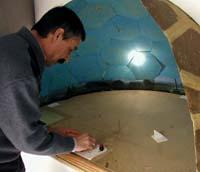
Awarded Sun
The three models of the class have been awarded in state competitions. The first is the sundial module. It can never be assured that it is unique in the world, but Esteban knows no other center that offers this module. There is a digital sundial, another that draws the time on a normal dial through optical fibers, a sundial with needles and many others. Many are made of simple material, paper or wood.
The second and third winning module are Esteban's favorites: Two modules that show the path of the Sun and, above all, its shadows. One is a dome with bulbs in which you select the time and date in which you want to simulate by a few switches and a bulb that indicates the position of the Sun is lit. Technically simple but effective. Students observe, for example, that in winter the journey of the Sun is very small and low, and in summer upside down. And it shows very well how solar clocks work and why they don't have the vertical stick.
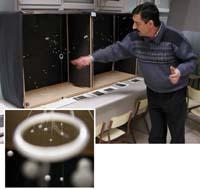
Great collection
There are many other modules, most related to astronomy and others related to astronautics or astronomers' instrumentation. There is a world map of the Moon, balances that measure the weight of many planets (similar to those we have in the bathroom of the house), etc.
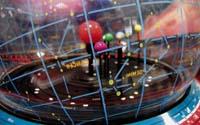
A curiosity: The Earth does not have a single satellite (the Moon), but two. The second, asteroid Cruithne 3753, is very small and far beyond the Moon. In the Durango Astronomy Hall, Esteban has made a small module explaining the orbit and position of this satellite.
The collection of modules is growing. Esteban constantly prepares new modules. "I always like to do something new. There is no lack of ideas... some go well, others don't." However, the classroom offer is growing gradually. For any astronomy lover, at least from a didactic point of view, Durango can be an interesting visit.
